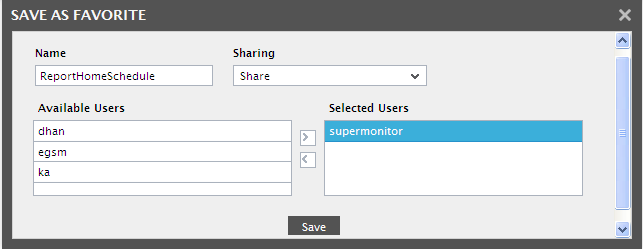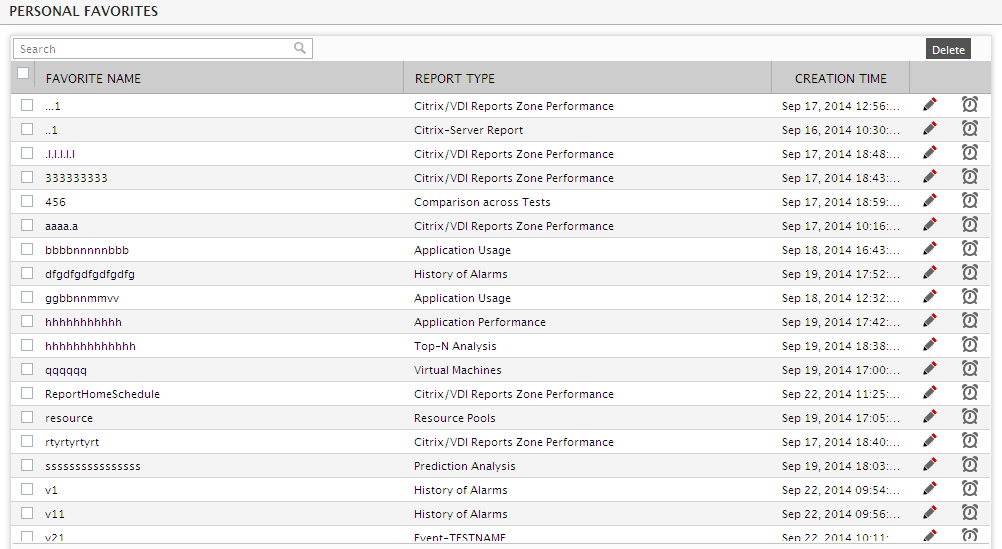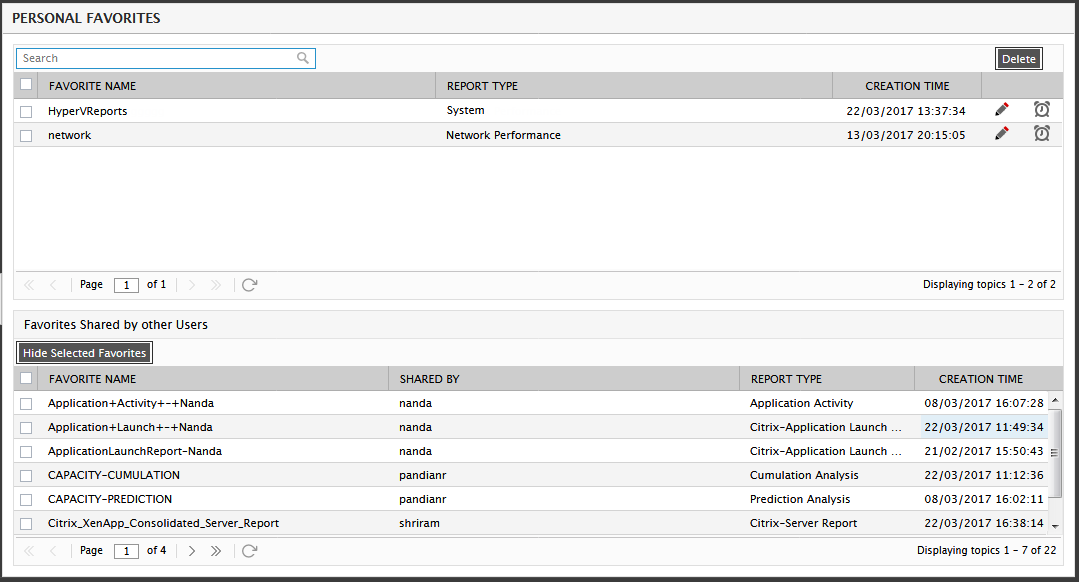How to Save the Report as a Favorite?
This section explains the step by step procedure involved in saving a generated report as a favorite.
To allow users to quickly access key reports, the eG Reporter allows users to save their frequently accessed reports as FAVORITES. To achieve this, first, click on the FAVORITES button.
-
This will result in the display of the SAVE FAVORITES page (see Figure 1). This page will display the report conditions mentioned in Figure 1. Now, give a Name to the report.

Figure 1 : Specifying the Report Name under which the report conditions are to be saved
-
To facilitate collaboration and knowledge sharing among administrators, eG Enterprise now allows users the flexibility to share useful favorites they create with other users. For sharing a favorite report, you need to first set a share type by selecting the desired option from the Sharing list box in Figure 1. The options are as follows:
- Private: If you set a favorite as Private, then all other users to the eG Enterprise system will be denied access to that favorite. Only the creator of the favorite will be able to access it.
-
Public: If you set the favorite as Public, then only users with the following rights will have access to it:
- Users with access to all the managed elements in the environment
- Users with access to the segment/service/zone/component for which the favorite report was generated
Note:
- Assume that a Zone report for a Default zone was added to FAVORITESand allowed Public access. Say, a zone named MyZone was later created, to which 2 independent components were added. A user named john was also created, who was granted monitoring rights to MyZone alone. This means that user john can monitor only the 2 independent components that are part of MyZone. This user, upon logging in, will not be able to access the report for the Default zone that was added to FAVORITES, in spite of the Public access. This is because, for user john a Default zone does not exist. eG Enterprise automatically creates a Default zone only when the target environment consists of components that are not part of any other zone. User john’s environment however consists of only the 2 independent components that are already part of MyZone; this eliminates the need for a Default zone, and thus explains why user john does not have access to the favorite report for the Default zone.
-
If a favorite report has been allowed Public access, then users whose monitoring scope does not include the component/segment/service/zone for which the report was generated will not be allowed access to that favorite.
-
Share: On the other hand, if you choose the Share option from the Sharing list, then you can pick and choose the users who need to be granted access to that view. To map users to a view, do the following:
- Select the users to be granted access from the Available Users list box.
- Then, click on Grant to grant the selected users access to the favorite. Doing so shifts the selection to the Selected Users list.
- To revoke the access permission granted to a user, you can select the user from the Selected Users list, and click the Revoke button.
- Finally, click on Update to save the changes.
Note:
-
Assume that a Zone report for a Default zone was added to FAVORITES. Say, a zone named MyZone was later created, to which 2 independent components were added. A user named john was also created, who was granted monitoring rights to MyZone alone. This means that user john can monitor only the 2 independent components that are part of MyZone. Also, assume that this user was allowed Share access to the favorite report for the Default zone.
However, when user john logs into eG Reporter, he will find that he is not able to view the favorite report for the Default zone that was shared with him. This is because, for user john,a Default zone does not exist. eG Enterprise automatically creates a Default zone only when the target environment consists of components that are not part of any other zone. User john’s environment however consists of only the 2 independent components that are already part of MyZone; this eliminates the need for a Default zone, and thus explains why user john does not have access to the favorite report for the Default zone.
- If a user is allowed Share access to a favorite report, but he/she does not have the privilege to monitor the component/segment/service/zone for which the report was originally generated, then the user will not be able to access the report, in spite of the Share access.
Note:
- A user without access to eG Reporter cannot view any of the favorites shared with him/her.
- A favorite can be deleted only by the user who creates it. The shared users on the other hand, can only view the favorites, and cannot delete them.
- Finally, click on SAVE to save the favorite.
-
When this is done, the following message (see Figure 2) will appear indicating that the Report Name has been automatically added to the FAVORITES list.

Figure 2 : A message stating that the Report Name has been saved successfully
-
Clicking on the View Favorites option from the FAVORITES tile of the eG Reporter will reveal a list of FAVORITE NAME comprising of report conditions saved for future use (see Figure 3). Note that this page will also appear if the Favorites link in Figure 2 is clicked. If too many favorites are listed in this page, you can quickly search for a particular favorite using the Favorite Search text box in this page. Specify the whole/part of the favorite name to search for in the Search text box, and click the
 button adjacent to it. All favorite names that embed the specified string will then appear in this page.
button adjacent to it. All favorite names that embed the specified string will then appear in this page.
-
If other users have shared their favorites with you, then details of those favorites will be listed separately in the Favorites Shared by other Users section as depicted in the Figure 3. This section provides the name of the shared favorite. Against every FAVORITE NAME, it displays the user who originally created the favorite and shared it with the current user in the SHARED BY column. The report type of the favorite is listed in the REPORT TYPE along with the time at which the favorite was created in the CREATION TIME. To hide the unnecessary shared favorites select the favorite you want to hide by providing a checkmark in the corresponding check boxes. Now click on Hide Selected Favorites. Doing so ensures that the chosen favorite as hidden.

-
If the favorites run across multiple pages, then a Page text box will be available at the bottom of every page. To go to a particular page, specify the page number in the text box and click on Enter button in your keyboard. Page navigation can also be performed using the arrow buttons available at the bottom of every page (see Figure 4). The purpose of each arrow button is explained below:
Button Purpose 
Click to go to the first page 
Click to go to the previous page 
Click to go to the last page 
Click to go to the next page - To reuse a favorite, the user would just have to click on the FAVORITE NAME displayed in Figure 4. Upon clicking, Figure 1 will reappear. To delete a favorite, just select the check box before the favorite to be deleted (see Figure 4), and then, click the DELETE button. To select all the favorites in a page for deletion, select the check box adjacent to the FAVORITE NAME at the top of the page.
